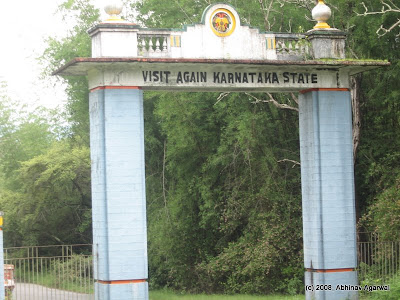View Larger Map
You can see the national parks and the forests that make up the Nilgiri Biosphere Reserve in the map above. At the top left is the Nagarhole National Park, now called the Rajiv Gandhi National Park, in Karnataka. Move down and there is the Bandipur National Park (link to park's page on the Project Tiger web site), also in Karnataka. Not marked on the map is the Muthunga Wildlife Reserve, also called the Wayanad Wildlife Santuary. It is the same forest, but in the state of Kerala. Move further down, and the forest is called the Mudumalai Wildlife Santuary and National Park in the state of Tamil Nadu. At the very bottom you have the Silent Valley National Park.
BTW, what's so great about the Nilgiris? Apart from the famous aromatic tea that is grown on the hills of the Nilgiris in Kerala and Tamil Nadu, these are also the ranges in the state of Tamil Nadu. The Nilgiris Biosphere Reserve is an international biosphere reserve in the Western Ghats, occupying an area of more than 6000 square kilometers in the states of Kerala, Karnataka, and Tamil Nadu. The Mudumalai National Park, Muthanga Wildlife Reserve, Bandipur National Park, Nagarhole National Park, and the Silent Valley National Park are part of the reserve. Which should give you ample hints that this is an area of incredible plant and wildlife diversity.
These photographs below are ones I took while driving through the Bandipur and Mudumalai national parks.

The road through the Bandipur National Park is quite ok. While it is not a good idea to speed through the park, any time, you can drive comfortably at 40-60kph, or even faster, but that would be silly, wouldn't it, to drive through a forest at high speed. Driving during the day is obviously more advisable since at night the animals come out and sometimes onto the road, so if you are driving at night it is likely you may not see them and end up injuring these animals. These wildlife reserves are the last remaining refuge for these wonderful animals, so take care.


Spotted deer, chitals are to be found by the hundreds, thousands in these parks. While that's a good sign, if there are too many herbivores abounding in a jungle, it is usually taken as a sign that there are not enough carnivores present in the jungle. In tiger reserves that is not a good sign, as it suggests that there are not enough tigers left, which is causing the deer population to balloon uncontrollably.
As you come to the end of the Bandipur national park, you are also at the Karnataka-Tamil Nadu border.


Enter the state of Tamil Nadu and the forest changes name. It is called the Mudumalai Tiger Reserve.

The Moyar river flows through the forest, and during the summer months it is not only a source of water for the animals, but also a good place to come by to spot these animals, since the smaller water holes and ponds have mostly dried up in the sweltering summer heat.


Just outside the Mudumalai reserve, or perhaps inside it, I do not remember, there are huge swaths of giant bamboos. These are immensely long, reaching up to 100 feet or so, and bend under their own weight, forming an amazingly beautiful canopy over the road.



If you care to stop at the Mudumalai sanctuary post office, you can pick up a collection of canceled stamps. Don't know what those stamps are. If I do, I shall write about them.

As you reach the border of the national park, the signs proclaim so.

And the Karnataka border and the Bandipur National Park beckons.


There are both wild and trained elephants in the forest. You are unlikely to come across wild elephants near the highway though.




This photo above is at the other end of the Bandipur national park, just outside the town of Gundalpet.